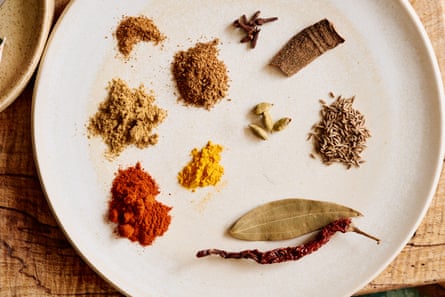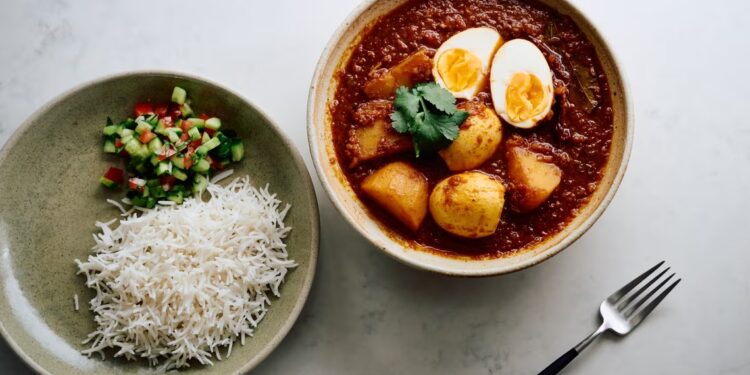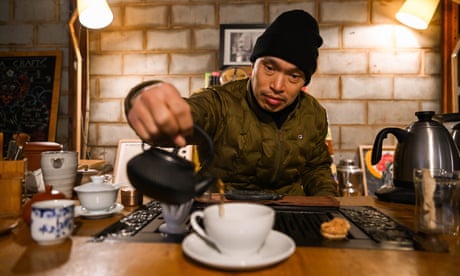urry, in Indian cuisine, is a construct. The word, thought to derive from the Tamil word kari (meaning sauce) and popularised during British rule, has become a catch-all for the countless sauced, semi-sauced, or soupy creations found across India. But with boundless varieties across the country’s regions and ethnic groups, the word curry is so expansive it is almost meaningless.
This is part of the reason why, on the menu at Sydney’s Raja, you’ll find the word in inverted commas to describe certain dishes. In Indian cuisine, says head chef Ahana Dutt, every dish has its own specific name. “When the English came … it was too hard to remember names, I guess.”
And this generalist nomenclature is perhaps a reason why so many modern recipes fail home cooks. Says Melbourne-based chef Rupal Bhatikar: “They try to give you [instructions] like: just dump everything in a pot and make it … It will taste like something, sure. But it won’t taste great.”

But what are the makings of a good curry? If you ask 100 chefs, you will get 100 different answers, says Sydney-based, Bangalore-born chef Shashank Achuta. “Good” is informed by regional cooking styles, personal experience, and availability of produce. Fortunately the latter bodes well for free-wheeling home cooks.
Although some lighter, broth-like styles of curry from Bengali cuisine – known as jhol in Bengali – can be made relatively quickly, says Kolkata-born Dutt, generally a good curry takes time.
This is because sauce-based Indian curries build layers of flavour through slow and steady cooking, patience, and salt. You also need onions, ginger and garlic; and whole and ground spices – but please, go easy on the turmeric.
Selecting spices
Generally, when making a curry, the whole spices are tempered first. Bhatikar divides whole spices into two categories: ‘to eat’ and ‘to perfume’.
A cardinal sin in Indian cooking is where everything just looks yellow.
Rupal Bhatikar
Cumin and brown mustard seeds, for example, are spices ‘to eat’ for texture and flavour. When making a curry that will serve two to four people, she recommends adding between one-quarter to one teaspoon of each spice.
‘Perfuming’ whole spices such as cinnamon or cassia bark, green or black cardamom, star anise, cloves and black peppercorn add length and aroma. “You want them through the dish, but you don’t want them shouting at your protein,” she says. Use two to three pieces of green cardamom, cloves and star anise; one pod of black cardamom (it has a more potent flavour than the green variety); and about a 2.5cm-long piece of cinnamon. (Substitute with powdered cinnamon at your peril.)

With ground spices, common additions are what Achuta calls the “big four” of Indian cooking: coriander powder, cumin powder, chilli powder and turmeric. Bhatikar recommends experimenting with one-quarter to one teaspoon of each spice.
Spice quantities and combinations vary depending on regional cuisine. Goan hooman, for example – coconut-based seafood curries from the south-west coastal state – tend to omit cumin, but include coriander and pepper; whereas heavier meat curries from Punjab increase the cinnamon, cloves and black cardamom.
But whatever you do, use restraint – especially with the turmeric. “A cardinal sin in Indian cooking is where everything just looks yellow. Nothing needs to be that yellow,” says Bhatikar. “Almost always I find recipes that say one teaspoon of turmeric powder. No. How many people are you cooking for?” A quarter of a teaspoon will do, she says; and you can always add more later if you need (you do not).
Temper your (whole) spices
Tempered spices – that is, spices bloomed in hot fat – are the fulcrum on which a curry’s greatness turns. The technique, and the result, is known by several names, but perhaps the most commonly used is tadka, in Hindi.
Your choice of fat will give some regional direction to your curry, says Bhatikar: mustard oil for north and north-east Indian flavours, gingelly oil (sesame oil) or coconut oil for the south, west and southwest (including Goa, Bhatikar’s home state) and neutral oils like vegetable or rice-bran from the centre. For a richer flavour, you could add ghee.

Dutt says it’s important to heat the oil or ghee until it smokes slightly. If the fat is too cold, spices such as mustard and cumin seeds will become bitter; if the oil is too hot, you will have to work quickly to prevent burning. “If you put curry leaves or mustard seeds in, it fires and goes everywhere and then people freak out,” she says.
Add whole spices, and let them pop and sizzle in the hot fat.
Frizzle your onions
Next, add your onions. Red onions are most typically used in Indian curries, but Bhatikar has used brown with success. Whether finely chopped or thinly sliced, it’s no big deal – this will affect the texture of the dish, but not the flavour.

The critical thing is to bhuno – from Hindi, the rough translation is to cook out an ingredient completely – the allium. It’s a very different technique from French cuisine, for example, which typically calls for caramelised or sweated onion over a low flame. Bhatikar says the gold standard is “frizzled onions” that are completely softened, but golden at the edges. “This is not the step to rush,” she says – although you can add a pinch of salt to hurry things along.
And a note on seasoning – Bhatikar likes to do this throughout the cooking process. “It’s always better to add a little salt at different stages instead of waiting to add too much salt too late.”
Add your ginger, garlic and ground spices
About a minute before your onions have achieved bhuno status, add your garlic or ginger (or both) – but not before. “Anytime you have that lingering bitterness in your curry, that’s because someone has burnt the ginger and garlic,” says Bhatikar.
And fresh – not jarred – is best.“If [I’m] lazy I’ll take a microplane or a grater and I grate it straight into the curry.” Some chopped green chillies can be added at this stage too.
Cook the ginger, garlic and chillies (if using) for some 30 to 45 seconds so they lose their raw, abrasive edge; then add your ground spices.
Add your wet ingredients – and wait for the oils to split
After your ground spices have toasted and become fragrant in the hot oil, only then should you add liquid. “Water is the enemy of the spice,” says Bhatikar. She often sees recipes calling for liquids such as water, coconut milk, yoghurt, or tomatoes too early. “What you’re effectively doing is diluting your spices.”
Stir through your liquid ingredients and simmer your curry until you see oil droplets form on the surface and the sides of the pan. “That’s the oil split and it’s magical, because that means that the curry has been cooked out correctly and the fat is released to the top,” says Bhatikar. “It’s the mark of a well-made curry.”

Add your protein, legumes or vegetables
Every curry has a “hero ingredient” backed by a sidekick, says Achuta. Methi malai matar, for example, is a creamy, fenugreek-powered pea stew; gongura kodi is a chicken curry soured with gongura (rosella) leaves.
If you’re cooking with meat, choose on-the-bone. Some butchers offer curry-cut chicken; drumsticks or shanks work well too. And a marinade, however basic, will make a world of difference. “It could be simple as turmeric and salt for 30 minutes while cutting your onions,” says Achuta. For extra depth, brown the meat in a hot pan before adding to the sauce.

Add whatever legumes or vegetables you like. Similarly to a stir-fry, add these in stages, starting with the ingredients that will take longest to cook: Potatoes and pumpkin first, cauliflower and eggplant next, peas last. Bhatikar sings the praises of tinned chickpeas: “One can of chickpeas and some potatoes will go a long way.”
Give it a rest
A lot of Indian dishes taste better the next day, says Bhatikar. “We are the kings and queens of meal prep.” An overnight stay in your fridge is ideal, but if this is not practical, a wait time of between 30 minutes to a couple hours will improve the flavour.

To finish
A second, simple tadka, such as with mustard seeds and curry leaves, will add to the complexity, says Achuta. Toasted, dried fenugreek leaves are common in the north; lentils, cumin seeds, asafoetida, curry leaves, and a garlic clove (unpeeled and lightly crushed, recommends Achuta) is a “universal temper” for the south. Spoon the tempered spices over the top of your curry when ready to serve.
Bhatikar says a squeeze of lemon or lime (add this after the heat has been turned off, or it will taste bitter), a drizzle of coconut, or some coriander leaves could do, too. Serve with rice, one of the dozens of breads of Indian cuisine, or, as Bhatikar sometimes likes, simply serve with good, crusty sourdough.




